Last Updated on July 7, 2024 by Max
Introduction
In the investigation for health and vitality, one often overlooked cornerstone is the power of a good night’s sleep. In this post, we will dive into the knowledge shared by Professor Andrew Huberman, a distinguished neurobiologist and ophthalmologist at Stanford School of Medicine, in his episode on sleep from The Huberman Lab Podcast. Professor Huberman brings a fresh perspective to the science of slumber, enriched by the latest scientific discoveries. Citing the influential work of Professor Matt Walker and his book “Why We Sleep,” Huberman not only restates sleep’s critical importance but also highlights a less discussed aspect: the sheer enhancement of life quality that optimal sleep brings. From improved focus and energy to a positive mood, the benefits of proper sleep are far-reaching.
Why focus on sleep in a space dedicated to prostate health, you may wonder? The answer lies in the complex relationships of our body’s health systems, where quality sleep stands as a critical pillar. Recent research underscores sleep’s profound impact on hormonal balance, immune system strength, and even the regulation of inflammation—all of which are vital for maintaining a healthy prostate. Moreover, the benefits of restorative sleep extend far beyond physical health, enhancing focus, energy levels, and overall mood, thereby improving our quality of life.
- Introduction
- Huberman’s Sleep Toolkit
- The Power of Morning Sunlight for Optimal Sleep and Alertness
- Professor Huberman’s Practical Tips for Morning Light Exposure
- Temperature’s Role in Sleep
- Nutrition and Exercise for Better Sleep
- The Second Critical Period: From Waking Until Three Hours After
- The Third Critical Period: Late Evening Hours
- “Sleep Stack” of Supplements
- Managing Sleep Apnea
- The Concept of The “Temperature Minimum”
- Conclusion
Huberman’s Sleep Toolkit
Professor Huberman introduces us to a comprehensive toolkit designed to enhance our sleep quality. These tools include light and darkness, temperature, food, exercise, caffeine, supplements, and digital resources, all playing pivotal roles in regulating our sleep.

The interplay between light and darkness acts as a primary cue for our nervous system, dictating our sleep and wakefulness. Exposure to light, especially sunlight, and the embrace of darkness at the right times can significantly influence our sleep quality. A cooler body temperature is conducive to better sleep, with our bodies naturally cooling down during sleep. Adjusting room temperature or using other methods to cool down before bedtime can help facilitate this process.
What we eat, when we eat, and the quantity consumed can impact our sleep. Timing meals and choosing foods wisely can support better sleep patterns. Regular physical activity, regardless of the type, increases body temperature and alertness, contributing positively to sleep quality if timed correctly. As a widely known stimulant, caffeine‘s timing and consumption levels are crucial for managing sleep. It blocks adenosine, a sleep-inducing chemical in the brain, thereby affecting sleep onset and quality.
Professor Huberman discusses several supplements like magnesium threonate, apigenin, theanine, glycine, GABA, and inositol, highlighting their potential to improve sleep quality and ease the process of falling and staying asleep, especially under specific dietary conditions or sleep challenges.
Beyond physical and nutritional strategies, digital resources such as non-sleep deep rest scripts and self-hypnosis techniques offer zero-cost options to enhance sleep quality. These tools can aid in relaxation and improving sleep proficiency without direct physical intervention.
The Power of Morning Sunlight for Optimal Sleep and Alertness
Delving into the perfect 24-hour cycle, Huberman starts from the moment of waking up, which varies from individual to individual, typically between 6:30 a.m. and 8:30 a.m. for most. A crucial natural process that occurs upon waking is the rise in body temperature, a primary catalyst for waking up. This increase in temperature prompts the release of cortisol, a hormone that, despite its negative reputation as a stress hormone, plays vital roles in enhancing immune function, metabolism, mental focus, and physical mobility when elevated at appropriate times, such as the morning.
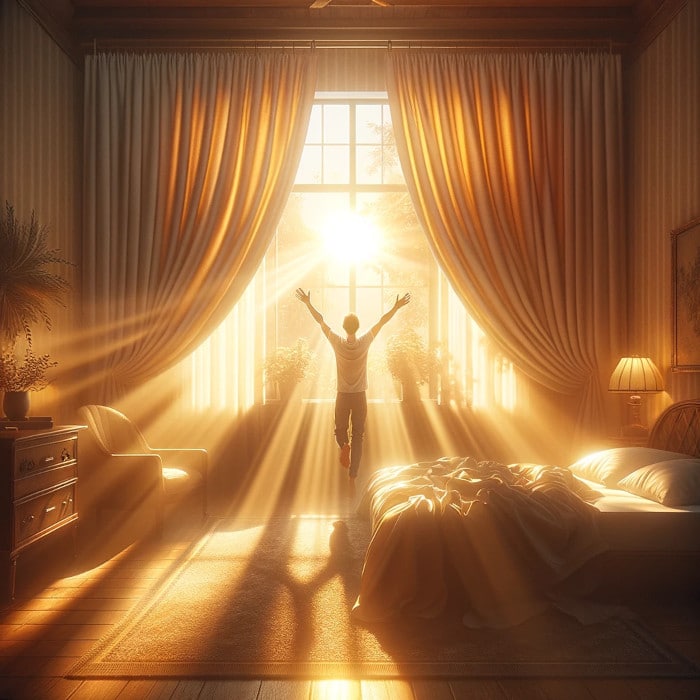
To harness the benefits of cortisol and ensure its peak aligns with morning hours, exposure to bright light, preferably sunlight, within the first 30 to 60 minutes after waking is recommended. This practice is vital for triggering an early cortisol increase, setting a positive tone for the day’s metabolic and cognitive functions.
Professor Huberman emphasizes the role of morning sunlight in optimizing sleep and enhancing daytime alertness. At the core of this process are photosensitive retinal ganglion cells in our eyes. These cells, responsive to bright light, especially in the morning, play a crucial role in regulating our sleep-wake cycle by signaling to the brain’s internal clock, the suprachiasmatic nucleus. This signaling cascade triggers a cortisol increase, essential for waking up and setting a timer for sleep onset later in the night.
Professor Huberman’s Practical Tips for Morning Light Exposure
Here are the condensed, yet essential, tips drawn from Professor Huberman’s insights:
| Limit Phone Screen Use | First thing in the morning, resist the urge to check your phone. The light from screens is insufficient for stimulating the cortisol increase necessary for optimal daytime alertness and sleep regulation. |
| Embrace Natural Sunlight | Venture outdoors to soak in natural sunlight as soon as possible after waking. The intensity and quality of outdoor light, even on overcast days, play a crucial role in regulating our internal clock. For optimal effect, engage in this practice within the first hour of waking up. On sunny days, aim for at least 5 minutes of exposure; on cloudy days, extend this to about 10 minutes; and on heavily overcast days, try to get at least 20 minutes of light. |
| Avoid Sunglasses, Opt for Corrective Lenses | To maximize the benefit of your morning light ritual, skip the sunglasses to allow the full spectrum of light to reach your eyes. If you need them, corrective lenses are recommended as they help focus the light onto the retina without blocking beneficial light waves. |
| Navigating Early Mornings and Cloudy Days | For early risers before sunrise, using artificial light is a temporary fix until daylight breaks. Remember, the goal is outdoor exposure, as natural light is paramount for synchronizing our circadian rhythms. On cloudy days, a little extra effort to get outside pays off, with the required exposure time extending up to 30 minutes depending on the level of overcast. |
| Seek Direct Exposure | Ensure you’re getting direct outdoor light, avoiding windows or windshields, as glass can filter out essential light components. |
| Alternative Light Sources | In regions with prolonged darkness or for those unable to get outside, daylight simulators or affordable ring lights can serve as effective stand-ins, helping maintain the natural cadence of our sleep-wake cycle. |
Getting outside shortly after waking, regardless of weather conditions, is not just about following a routine; it’s an invitation to revitalize our bodies and minds. It’s a moment to enjoy the simplicity of life, perhaps accompanied by a morning beverage, a pet, or loved ones, ensuring this becomes a cherished part of your daily rhythm.
Interestingly, animals instinctively embrace the sun’s warmth and light, an innate wisdom that humans often overlook. Yet, as we learn more about the science behind sunlight’s benefits, it’s clear this practice is something we should weave into our lives, aiming.
If you find yourself waking up before the sun rises and needing to stay awake, turning on artificial lights in your home is recommended to kickstart the day. However, once the sun is up, it’s crucial to engage in direct sunlight exposure, as artificial lights, despite their brightness, fall short of activating the body’s cortisol mechanism and other wake-up processes as effectively as natural sunlight does.
A unique aspect of our biology is that while we require substantial light in the morning to wake up fully, even a minimal amount of artificial light at night can disrupt our sleep patterns. This asymmetry emphasizes the importance of maximizing light exposure in the morning while being cautious about light exposure at night.
Temperature’s Role in Sleep
After addressing the crucial role of sunlight in waking up, Professor Huberman moves on to explore other essential tools for optimizing wakefulness and sleep, focusing on temperature, food, exercise, caffeine, supplements, and digital tools. Early in the day, he highlights, it’s beneficial to not just seek light but also use temperature as a mechanism to aid wakefulness.

One effective method to increase core body temperature more swiftly is engaging in cold water exposure. This could take the form of a cold shower lasting one to three minutes, an ice bath, or a cold plunge in a tub designed for cold exposure. The shock of cold water not only immediately wakes you up through the release of adrenaline (epinephrine) from both the brain and the adrenal glands but also helps to increase your core body temperature. This occurs because the body reacts to the cold surface by warming up internally, a response managed by the brain to maintain a balanced internal temperature. Interestingly, a brief cold water immersion for one to three minutes can indeed make the body’s core temperature rise once you step out of the water. This process not only makes you feel more alert but also boosts dopamine levels, contributing to improved focus and motivation.
Nutrition and Exercise for Better Sleep
Professor Huberman personally adopts this practice, layering it with exercise to maximize its wakefulness effects. He mentions that exercise is another powerful way to elevate core body temperature early in the day. He outlines that the optimal times for exercising, according to research, are right after waking up, three hours after waking, or eleven hours after waking. However, the specifics can vary based on individual schedules and goals.
For those looking to integrate exercise into their morning routine, Professor Huberman suggests combining it with sunlight exposure for efficiency. Activities like walking, light jogging, or skipping rope can be done while basking in the morning sun. Following this, he takes a cold shower to further enhance his alertness.
Professor Huberman recommends physical activity five to seven days a week, noting that he aims for six days a week, occasionally five, but seldom seven. Through combining sunlight exposure, cold water immersion, and exercise, he presents a comprehensive approach to kickstart the body’s wakefulness and ensure a productive and alert start to the day. In discussing the importance of food as a lever for optimizing sleep and wakefulness, Professor Huberman delves into the timing and nature of food consumption. Eating early supports a biological clock mechanism, enhancing alertness by increasing metabolism and body temperature. While it’s not mandatory to eat early, combining different tools like sunlight exposure, exercise, cold water immersion, and caffeine can synergistically affect these mechanisms. Interestingly, caffeine also slightly raises body temperature due to the adrenaline it stimulates, further illustrating how these tools can interplay. The discussion on food also extends to what is consumed, emphasizing that the choice of breakfast (or skipping it) is highly personal and influenced by individual health goals and lifestyle. Huberman touches on the broader conversation about eating for energy, highlighting that the volume of food consumed is a critical factor often overlooked. A large meal can lead to sleepiness regardless of sleep quality the night before or the time of day, as the body diverts resources to digestion, reducing energy available for other functions.
The Second Critical Period: From Waking Until Three Hours After
Professor Huberman outlines that the strategies employed from waking until about three hours after, serve as the foundation for maintaining wakefulness, focus, and good mood throughout the day, and importantly, setting the stage for optimal sleep at night.
The second critical period spans from midday through the afternoon and into the evening, leading up to bedtime. During this time, managing caffeine intake to avoid consumption too late in the day is crucial to prevent sleep disturbances. Additionally, for those who appreciate naps, like Professor Huberman himself, incorporating non-sleep deep rest (NSDR) or sleep hypnosis sessions can offer restorative benefits without compromising nighttime sleep quality.
Light, especially sunlight, has profound effects not just in the morning but throughout the day, influencing hormone production, mood, libido, and more. Late afternoon and early evening sunlight exposure is beneficial as it serves as a second daily anchor point for our internal clock. This period of sunlight exposure communicates with the evening oscillators of our circadian clock, differentiating it from morning light through the unique wavelengths present at these times of the day. Morning sunlight tends to have a higher ratio of blue to yellow light, signaling wakefulness, while the evening light, with a shift towards orange and red hues, indicates the day’s end, preparing the body for sleep. By understanding these nuanced interactions between light and our biological systems, we can better harness natural environmental cues to optimize our health and well-being.
The Third Critical Period: Late Evening Hours
During the late evening hours, known as critical period three, the focus shifts to preparing for optimal sleep. Professor Huberman emphasizes the importance of managing light exposure during this time to ensure a smooth transition into sleep. He advises against the use of bright artificial lights of any color in the evening, as they can activate wakefulness mechanisms in the brain, counteracting the body’s natural progression towards sleep. This sensitivity to light in the evening contrasts sharply with the morning, where bright sunlight is beneficial and necessary for alertness.
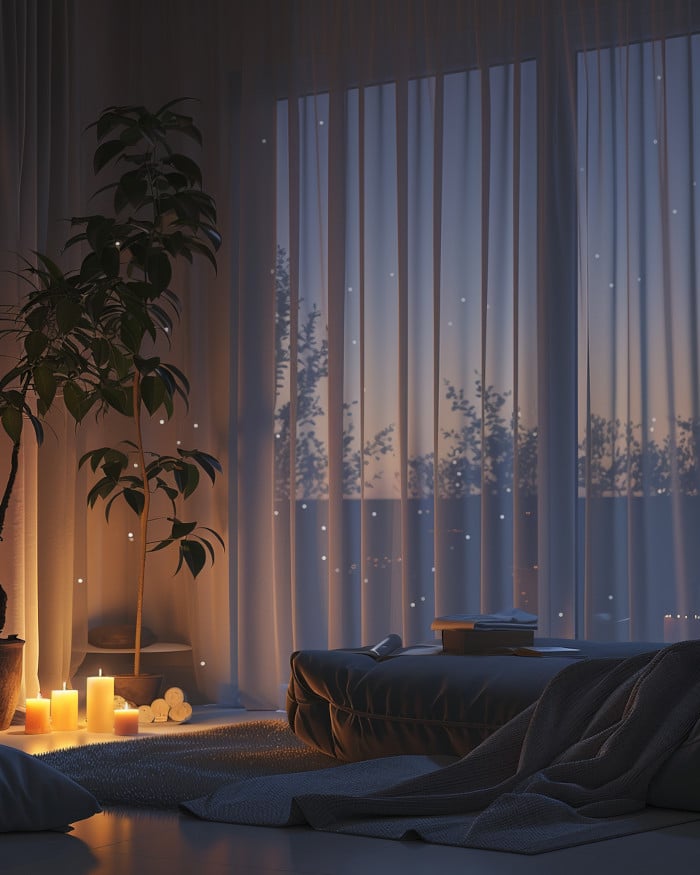
To mitigate the impact of artificial light on sleep, dimming indoor lights once the sun has set is recommended. This doesn’t mean living in darkness but adjusting the lighting to a softer, more subdued level that’s conducive to relaxation and sleep readiness. Placing lights lower in the room, such as using desk lamps or floor lamps instead of overhead lighting, can also help mimic the natural decrease in light as the day ends, aligning more closely with the body’s internal clock.
When artificial light is necessary for evening activities, the guidance is to use as little as possible. Dimming screens on electronic devices and prioritizing candlelight or moonlight when feasible are suggested to minimize the sleep-disrupting effects of light. This careful management of light exposure in the hours leading up to bedtime forms a crucial part of the daily rhythm, reinforcing the body’s natural sleep signals and supporting overall sleep quality. In managing your environment for optimal sleep during what Professor Huberman calls “critical period three,” he stresses the significance of light and temperature control. Moonlight and candlelight, he explains, provide very low light intensity—only about three to 10 lux—far less than the brightness from artificial sources like desk lamps or overhead lights, which can range from a hundred to a thousand lux. Evening exposure to sunset light can slightly counteract the effects of nighttime artificial light, though it’s not a complete solution. Engaging with natural light at sunset helps signal the body that evening is approaching, preparing it for rest.
Temperature manipulation is another tool for sleep optimization. Unlike the morning, when cooler temperatures can invigorate the body, warming up in the evening with a hot bath or sauna can facilitate sleep. This practice, followed by a slight cool down, triggers a drop in core body temperature, aiding in the transition to sleep.
For the sleeping environment itself, Huberman suggests keeping it cool, ideally lowering the room temperature by at least three degrees. Technology like temperature-controllable mattress covers, or simpler solutions like fans or open windows, can achieve this. The strategy allows individuals to adjust their warmth with blankets as needed without overheating, highlighting the body’s natural temperature regulation mechanisms through areas like the palms, feet, and face. This careful management of light exposure and temperature in the evening supports a conducive sleep environment, enhancing the quality of rest.
The rationale behind a cooler sleeping environment relates to the body’s natural mechanisms for temperature regulation, notably through areas with glabrous skin—such as the palms, face, and soles of the feet. These areas are efficient at dissipating heat, helping to manage body temperature during sleep. If you become too warm under the blankets, instinctively extending a limb can aid in cooling down, a simple yet effective way to maintain a comfortable temperature throughout the night. Professor Huberman advises against wearing socks to bed for those who frequently wake up feeling too warm, as covering the glabrous skin on the feet can hinder the body’s ability to regulate temperature effectively. Adjusting core body temperature by one to three degrees can significantly improve your ability to fall asleep and remain asleep. For those who find themselves overly alert in the evening, possibly due to late-day exercise or caffeine consumption, manipulating body temperature can aid in transitioning to a state of calmness conducive to sleep. This could involve taking a hot shower or bath before bed, which, upon cooling down afterward, can lower your body temperature and facilitate sleep onset, even if not entirely counteract the effects of caffeine.
Additionally, Huberman addresses inquiries about alcohol, CBD, and THC. He shares personal reasons for not consuming alcohol, mainly due to its impact on sleep quality. Echoing insights from Dr. Matt Walker, he explains that while substances like THC and alcohol seem to aid sleep initiation or duration, they degrade sleep architecture, leading to less restorative rest.
“Sleep Stack” of Supplements
He outlines a “sleep stack” of supplements, which includes magnesium threonate, apigenin, and theanine, known for their safety and effectiveness in improving sleep. However, he advises consulting a physician before making any changes to your supplement intake. The suggested dosages are:
- Magnesium threonate: Around 145 milligrams, adjusted as necessary.
- Apigenin: 50 milligrams, which can be taken alone.
- Theanine: 100 to 400 milligrams, also adjustable based on individual response.
These supplements, taken individually or together, may help with falling asleep, achieving deep sleep, and waking up refreshed without the grogginess often associated with poor sleep quality or sleep aids like alcohol or THC. Huberman emphasizes the importance of starting with behavioral modifications for sleep improvement before moving to nutrition and supplementation, and, if necessary, consulting a healthcare provider for prescription options.
For individuals exploring the use of supplements to improve sleep, Professor Huberman offers practical advice regarding magnesium threonate, apigenin, and theanine. It’s important to note that while these supplements can enhance sleep quality for many, they may not suit everyone.
Magnesium Threonate: Approximately 5% of individuals may experience digestive issues such as diarrhea or discomfort when taking magnesium threonate. If you encounter these adverse effects, it’s advised to discontinue its use. The ideal dosage for those adversely affected would effectively be zero milligrams.
Theanine: Although beneficial in terms of sleep quality, theanine at doses starting from 100 milligrams may induce vivid dreams for some users. These intense dreams could potentially disrupt sleep or cause middle-of-the-night awakenings. Individuals who experience such effects may consider omitting theanine from their regimen, focusing instead on supplements like magnesium threonate and apigenin that do not provoke this response.
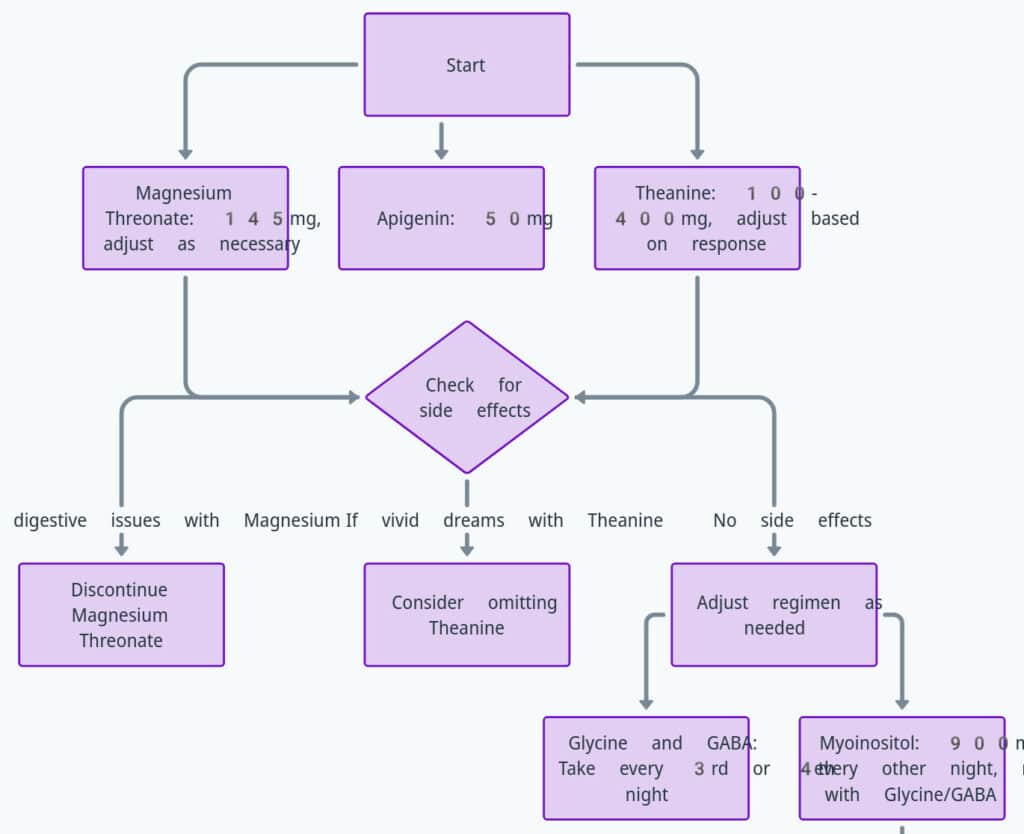
The key takeaway is to listen to your body’s reactions to these supplements. Adjusting the sleep stack to exclude components that cause discomfort or disrupt sleep is crucial in finding the most effective and comfortable solution for enhancing sleep quality.
Prof. Huberman emphasizes a strategic use of glycine and GABA, taken every third or fourth night, to maintain the effectiveness of his sleep stack. Huberman notes that overuse may diminish the benefits, though the exact reason remains unclear. This careful scheduling ensures that the positive effects on sleep are maximized.
Expanding his regimen, Huberman has introduced myoinositol, taking 900 milligrams every other night alongside magnesium threonate, apigenin, and theanine—but not on the nights he takes glycine and GABA. This addition, he finds, significantly boosts his ability to fall asleep swiftly and return to sleep easily after nocturnal awakenings, which he mentions as a common occurrence. Without myoinositol, these awakenings become more challenging to manage.
The benefits of Myoinositol extend beyond just sleep; Huberman observes a notable reduction in anxiety and a general increase in calmness and stress resilience throughout the day. This is attributed to inositol’s interaction with the serotonin system, aligning with the scientific literature on its mental health benefits.
To share these insights and more, Huberman mentions the Neural Network Newsletter’s sleep kit. This free resource outlines supplements and behavioral strategies for better sleep but does not cover the latest findings on inositol which he finds crucial for enhancing sleep quality, particularly in falling back asleep. To ensure inclusivity, Huberman highlights zero-cost alternatives for improving sleep, such as NSDR protocols available on YouTube and various free resources online, ensuring that valuable sleep improvement tools are accessible to all, regardless of financial means.
Managing Sleep Apnea
Lastly, Huberman addresses sleep apnea, a significant sleep disruption source. He explains that sleep apnea, characterized by breathing interruptions, can affect not only those with obesity but also individuals with high muscle mass. Sleep apnea is not just a minor inconvenience; it’s a significant health risk linked to various serious conditions, including cardiovascular problems, sexual dysfunction, and cognitive issues. Many individuals rely on Positive Airway Pressure (PAP) devices, resembling snorkel masks, to mitigate this condition. However, Huberman suggests a more accessible approach that could benefit everyone, regardless of the severity of their sleep apnea: becoming a nose breather during sleep. The practice of nose breathing, as opposed to mouth breathing, is extensively advocated for its health benefits, a topic thoroughly explored in James Nestor’s book, “Breath: The New Science of a Lost Art,” and discussed in various podcasts. Nose breathing is particularly advantageous during sleep, enhancing overall sleep quality and reducing the likelihood of snoring and sleep apnea.
For those struggling to maintain nose breathing while asleep, Huberman recommends a simple yet effective method: using a small piece of medical tape to gently keep the mouth closed. This encourages nose breathing throughout the night. Additionally, he proposes incorporating nose breathing into low-intensity cardiovascular exercises as a training mechanism. This can be achieved by either taping the mouth shut, holding a gulp of water in the mouth without swallowing, using a mouthpiece, or consciously keeping the mouth closed. Although challenging at first, this practice can significantly improve one’s ability to breathe comfortably through the nose during both waking and sleeping hours.
A crucial aspect of achieving consistent, high-quality sleep, according to Prof. Huberman, involves managing weekend sleep patterns. Huberman advises limiting the extension of sleep on weekends or after late nights to no more than an hour beyond your regular wake-up time. For instance, if you usually sleep for eight hours and wake up at 7:00 a.m., it’s acceptable to wake up at 8:00 a.m. during the weekend or after a night out. However, extending sleep until 11:00 a.m. or noon, with the intention of “catching up” on sleep, is not advisable. Instead, aiming for a consistent wake-up time—with a deviation of plus or minus one hour—and possibly incorporating an afternoon nap, provided it’s not excessively long, is recommended for optimal sleep health.
The Concept of The “Temperature Minimum”
Huberman introduces the concept of the “temperature minimum,” a critical time point occurring approximately two hours before your typical wake-up time when your body is at its lowest temperature within the 24-hour cycle. Engaging in activities like viewing bright light, exercising, or consuming caffeine during the two to four hours before your temperature minimum can delay your sleep clock, making you want to sleep and wake up later. Conversely, exposure to these stimuli immediately after the temperature minimum can advance your sleep clock, encouraging an earlier bedtime and wake-up time. By strategically timing activities like exercise and caffeine consumption relative to your temperature minimum, you can manipulate your sleep clock to better align with your schedule, whether traveling or adapting to shift work. For shift workers, Huberman recommends sticking to the same shift for at least two weeks at a time to minimize the strain on the brain and body. Additionally, for those needing to be awake during their usual sleep hours, using red light can mitigate the disruption to the sleep cycle.
Through these insights, Prof. Huberman offers a comprehensive toolkit for enhancing sleep quality and managing sleep-related challenges, emphasizing the significance of understanding and working with our body’s natural rhythms. Understanding how our internal clock, or circadian rhythm, operates is crucial for optimizing our sleep and overall well-being. Prof. Huberman sheds light on the concept of the “temperature minimum”—a pivotal moment occurring roughly two hours before your regular wake-up time when your body is at its lowest temperature within a 24-hour cycle. This period has a significant impact on sleep patterns and how we can manipulate our sleep cycle for better health and productivity.
For instance, engaging in activities like turning on bright lights, consuming caffeine, or exercising during the hours leading up to this temperature minimum can delay your sleep cycle. This means if you wake up at 7:00 a.m. typically, and your temperature minimum is at 5:00 a.m., actions taken at 3:00 a.m. or 4:00 a.m. could push your sleep and wake times later. Conversely, exposing yourself to bright light, engaging in physical activity, or eating shortly after reaching your temperature minimum can advance your sleep cycle, encouraging earlier sleep and wake times. When it’s necessary to be awake at odd hours, Huberman suggests using red light to minimize disruptions to the body’s cortisol rhythm. While not ideal for those needing to reverse their sleep schedule entirely, it’s useful for occasional late nights or early mornings.
Conclusion
Huberman concludes by underscoring the foundational role of sleep in mental, and physical health, and overall performance. Implementing the strategies he outlines, from light and temperature management to exercise and caffeine timing, can profoundly impact sleep quality and, by extension, daytime alertness and focus. He encourages leveraging these tools, most of which are zero-cost, to optimize sleep and enhance overall well-being. In sharing Professor Huberman’s insights, I hope to inspire not just an appreciation for the complex beauty of sleep but a practical engagement with these strategies in your daily lives.
Ready to Transform Your Sleep? We’d love to hear about your journey towards better rest. Share your experiences, questions, or any tips you’ve discovered in the comments below.



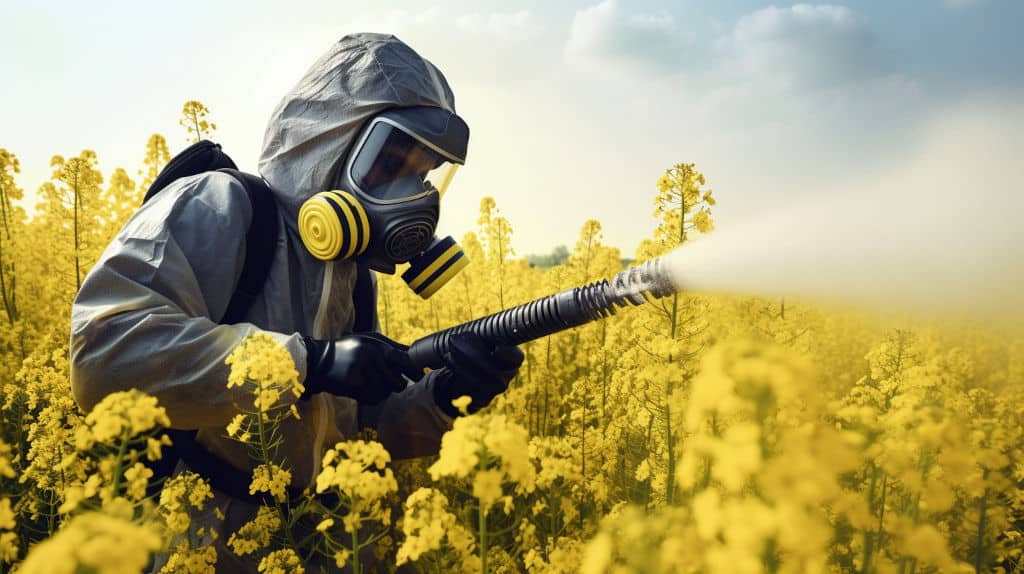
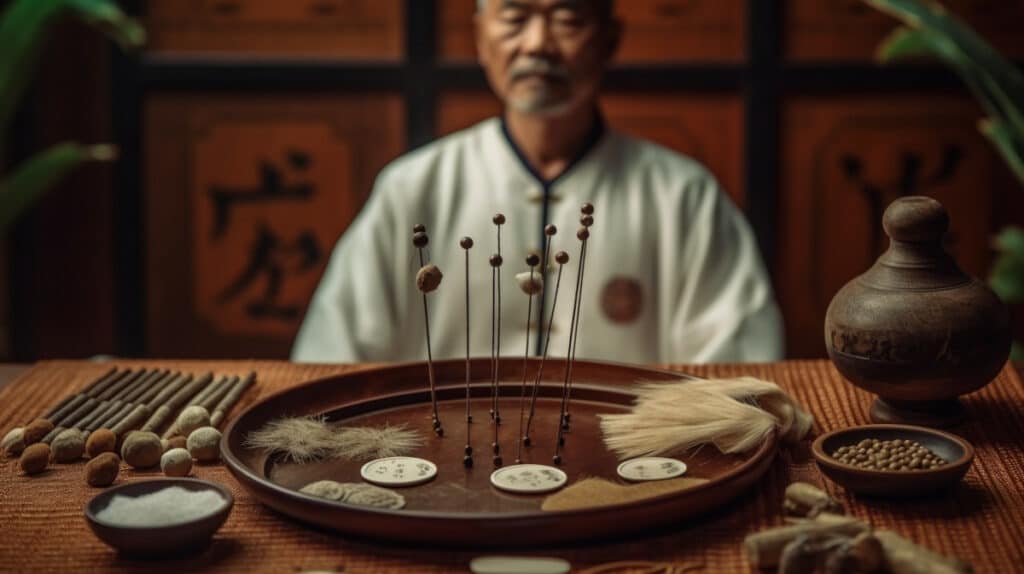
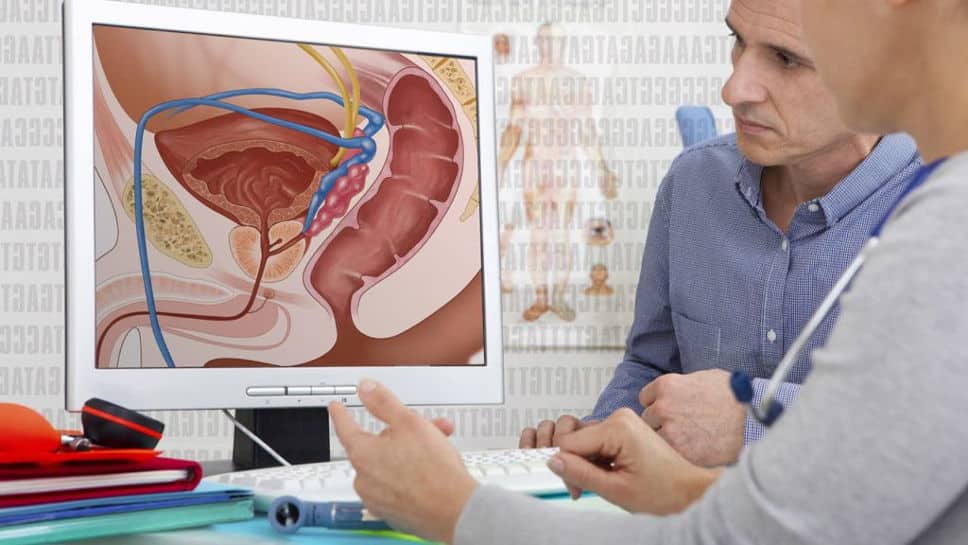

Glad I find this blog post. As someone who struggles with getting a good night’s sleep, this post really resonated with me. Sleep has always been a challenge for me, and I often find myself feeling groggy and unfocused during the day because of it. Reading about Professor Huberman’s insights into the science of sleep and the practical tips he offers was incredibly enlightening.
I particularly found the discussion about the power of morning sunlight fascinating. It’s something I’ve heard about before, but I didn’t realize just how crucial it is for setting our internal clocks and regulating our sleep-wake cycle. I’m definitely going to make an effort to get outside and soak in some sunlight as soon as I wake up, even if it’s just for a few minutes.
The advice about managing light exposure and temperature in the evening also caught my attention. I’ve always been aware of the negative effects of screen time before bed, but I didn’t realize just how much artificial light, even from indoor sources, can disrupt our sleep patterns. I’ll definitely be more mindful of dimming the lights and creating a relaxing environment in the hours leading up to bedtime.
Overall, I’m excited to start implementing some of these strategies into my daily routine and see if they make a difference in my sleep quality. Thank you for sharing this valuable information!
Hi Sharon,
I’m so glad to hear that the post resonated with you and offered new insights into improving your sleep! It’s wonderful that you’re planning to embrace morning sunlight and adjust evening light exposure to benefit your sleep-wake cycle. These small yet impactful changes can indeed make a significant difference in sleep quality and overall well-being. I’m excited for you to experience the positive changes these adjustments can bring. Keep us updated on your progress, and feel free to share any further discoveries you make along the way!
Best wishes,
Makhsud
This is a great collection of tips for getting better sleep. I travel a lot, and recently bought a satin eye mask for those times when the hotel curtains/blinds just won’t shut all the way. I can’t believe what a difference the mask makes in my sleep quality! I’m not sure about the cold showers, but I’m willing to give anything a try to see how it works. I do like having my bedroom pretty chilly when I sleep. And lastly, I found the info about mouth breathing vs nose breathing particular interesting because I recently started mouth taping at night, and also noticed a big difference in how rested I feel when I wake up in the morning.
Hi Dave,
I’m glad to hear the sleep tips are making a difference for you! The satin eye mask is indeed a game-changer for many travelers. As for cold showers, they’re not everyone’s cup of tea, but experimenting to see what works best for your routine can be quite revealing. It’s interesting to hear about your positive experience with mouth taping; it’s amazing how small changes can significantly impact sleep quality and how rested we feel. Keep exploring what works best for you!
Best wishes,
Makhsud
This is a fascinating read on the importance of not only sleep, but also the right conditions for waking up and setting the scene for the day. I had no idea that bright light, and ideally sunlight, plays such a crucial role in waking up. And we often hear so many bad things about cortisol, that it is great to see that cortisol is very important when we wake up in the mornings.
I am fortunate enough to be living close to the ocean, and I have a swim early in the morning on most days. I always feel invigorated afterwards, so it is interesting to see that cold water can also increase the core body temperature. Does one get the most benefit from a cold swim or shower early in the morning, or is anytime during the day good? Is there a recommendation for how long one should be in the cold water?
Dr Huberman seems to have a vast knowledge, do you have a link where one can listen to more of his podcasts? Or will you share more of his work on this site? Thank you.
Hi LineCowley,
I’m thrilled you found the post intriguing! Indeed, starting the morning with bright sunlight and a bit of cortisol can really set a positive tone for the day. Regarding your question, morning cold exposure, like your ocean swims, tends to be most beneficial for kick-starting the body’s systems, though any time that fits into your routine can still offer great benefits. Typically, a few minutes in cold water is sufficient to see effects. For more on Dr. Huberman’s insights, his podcast is a fantastic resource, often available on popular podcast platform “The Huberman Lab” at https://www.hubermanlab.com/all-episodes. Stay tuned for more posts inspired by his work!
Best wishes,
Makhsud
Dr. Huberman’s sleep tips have been a revelation for me. His emphasis on a consistent sleep schedule and minimizing light exposure before bed has transformed my nights. Implementing a nightly wind-down ritual has signaled to my body that it’s time to rest, while dimming lights and limiting screen time has helped regulate my circadian rhythms.
Additionally, his advice to optimize the sleep environment by keeping the bedroom cool and dark has made a remarkable difference in my sleep quality. These small yet impactful changes have turned restless nights into rejuvenating mornings. Thank you, Dr. Huberman, for sharing practical strategies rooted in science that have empowered me to take control of my sleep health.
Thank you Chris for commenting!
I am constantly looking for ways to get a better night’s sleep and also train my body to stay asleep. I never thought about the fact that natural light is paramount for synchronizing our circadian rhythms, although I have heard that it is better to wake up at the same time each day.
I would love to train my body to wake up at six instead of 3 or 4 am. What are your suggestions for falling asleep again easily if you do wake up at the wrong time?
Hi Michel,
Improving early morning wakefulness can be challenging, but here is a strategy to help you drift back to sleep:
Avoid worrying about waking up too early, as stress can keep you awake longer. Practice deep breathing to relax. Stay away from bright lights and screens. If you need light, use a dim one that doesn’t emit blue light. Check that your sleep environment (temperature, noise, bedding) is optimized for comfort. Engage in activities like progressive muscle relaxation or visualization to calm your mind. If you’re awake for more than 20 minutes, do a quiet activity like reading under soft lighting until you feel sleepy. A consistent bedtime, avoiding late caffeine or screens, and relaxing before bed can support uninterrupted sleep. Get exposure to natural light upon waking to help set your internal clock for an earlier wake time.
Patience and consistency are key, Michel. If sleep troubles persist, consider using a sleep stack of supplements proposed by Prof. Huberman and presented in the post.
Happy sleeping,
Makhsud
Hi Max, thanks for the thorough and informative article about prostate health.I had no idea that the prostate and sleep are interconnected.As someone who often rises pre-dawn, it’s often more than an hour before I see any sunlight or daylight. It never occurred to me that it has anything to do with my sleep.This article is packed with info on sleep hygiene! I never knew about the light exposure impact. I’m going to try the morning/evening routine.Thanks for sharing! Always looking for better sleep. Trying the tips like avoiding big meals before bed and a cooler room at night. This is a great resource – clear, informative, and easy to understand. Professor Huberman’s toolkit sounds promising!
Hi Bob,
I’m really glad you found the article enlightening and helpful! It’s fascinating, isn’t it, how interconnected our bodily systems are, with something as seemingly unrelated as prostate health having a link to our sleep patterns. The impact of natural light on our sleep-wake cycle is one of those aspects of health that often goes overlooked, but it’s incredibly influential.
It’s great to hear that you’re planning to incorporate the morning and evening routines to get more exposure to natural light. Adjusting your exposure to light, alongside the other sleep hygiene practices like avoiding large meals before bed and keeping your sleeping environment cooler, can make a significant difference in your sleep quality.
Professor Huberman’s approach, incorporating supplements like myoinositol, magnesium threonate, apigenin, and theanine in a carefully timed regimen, offers a fascinating insight into how we can further optimize our sleep. It’s all about finding the right balance and combination that works for each individual’s unique physiology.
I’d love to hear how these changes work out for you, so feel free to share your experiences as you try out these tips!
Here’s to better sleep and brighter mornings ahead!
Warm regards,
Makhsud
It’s not just about snoozing; it’s about how sleep affects everything from our mood to our immune system. Huberman shares some neat tricks, like catching morning sunlight to kickstart your day and using temperature changes to help you doze off at night. Plus, there’s a whole bunch of advice on supplements and managing sleep apnea. It’s like having a friendly chat with a sleep guru who’s got all the insider tips for getting the best shut-eye possible.
Hi JR,
You’ve hit the nail on the head! Sleep indeed influences every aspect of our well-being, from our emotional state to our body’s defense mechanisms. It’s fantastic to see you’ve appreciated the depth and breadth of the insights shared in the article. Dr. Huberman’s approach of integrating simple, natural strategies with science-backed supplement advice offers a holistic view of enhancing sleep quality.
I’m delighted you found the conversation with our “sleep guru” so enriching. It’s all about sharing knowledge in a way that’s accessible and actionable. If you experiment with any of Huberman’s tips or have some sleep hacks of your own, I’d love to hear about your experiences!
Thank you for your engaging feedback, and here’s to all of us enjoying better, more restorative sleep!
Warm regards,
Makhsud
Hey Max,
The insights shared by Dr. Huberman about enhancing sleep quality are incredibly fascinating and highlight the interconnectedness of our daily habits with our sleep-wake cycle. It’s intriguing how factors like exposure to morning sunlight, temperature adjustments, and even the timing of caffeine consumption can significantly impact our sleep. This holistic approach underscores the power of aligning our routines with our biological rhythms for better health and well-being. Engaging in discussions about these practices enlightens us about the science behind sleep and encourages us to experiment and find what best suits our individual needs. It’s a reminder of how small lifestyle tweaks can significantly improve our daily lives. What’s particularly compelling is the emphasis on natural, accessible strategies everyone can try, making the quest for better sleep more inclusive and actionable.
Hi Sara,
I’m so glad you found Dr. Huberman’s insights as useful as I did! It’s truly remarkable how the small details of our daily routines, like when we choose to enjoy our morning coffee or soak up some sun, can weave together to significantly enhance our sleep quality.
Thank you for sharing your thoughts and for being part of this discussion. Let’s keep experimenting and sharing our discoveries on this journey to not just good, but great mornings!
Warm regards,
Max
This is a very insightful article. We have all been told about the importance of getting sufficient sleep but the detail you go into helps us understand the process.
You have given us tools to ensure we can take the action steps to get the best sleep for our physical health and mental health. I have learned something new about the importance of natural sunlight in the morning. I will add it to my morning routine and journal the differences I feel in my physical and mental health.
Thank you for sharing this.
Hi Etana,
Thank you so much for your thoughtful comment! It’s heartening to hear that the article shed new light on sleep and its profound impact on our overall health. Knowing that you’ve found actionable tools within the piece to enhance your sleep quality is exactly the outcome I hoped for. I’d love to hear about your observations and any other tweaks to your routine that make a difference. Thanks again for sharing your plans and enthusiasm. Here’s to brighter mornings and restful nights ahead!
Warmly,
Max
What an awesome article on sleep! As a chronic disease sufferer sleep is so important and it wasn’t until recently that I began having problems with my sleep even though I’ve had this disease for years. Your article on this issue is a wonderful and complete guide to helping anyone achieve better sleep and even taught me things I’d never thought about and how waking properly is as crucial to sleep as is readying for sleep. Anyone can take these tools and apply them to gain more beneficial sleep to live better. Thank you!
Hi Monika,
I’m truly moved by your feedback and grateful to hear that the article offered you new insights into improving your sleep, especially given the challenges you’ve faced as a chronic disease sufferer. It’s a powerful reminder of how pivotal quality sleep is to our health and well-being, and how changes in our condition or habits can unexpectedly impact our sleep patterns.
Thank you for taking the time to share your experience and for your kind words. If you ever have more insights or questions as you implement these strategies, I’d love to hear from you. Wishing you many restful nights and energized mornings ahead!
Best wishes,
Max